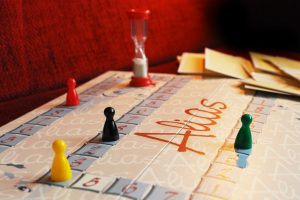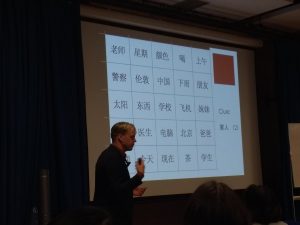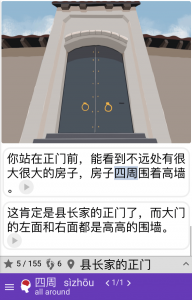 This article was written as a follow-up to a keynote presentation and a workshop held by me at the 15th Annual Chinese Teaching Conference organised by University College London Institute of Education Confucius Institute for Schools, 2018. The original article was published here, but I publish it here too because I believe it is useful for students as well as teachers.
This article was written as a follow-up to a keynote presentation and a workshop held by me at the 15th Annual Chinese Teaching Conference organised by University College London Institute of Education Confucius Institute for Schools, 2018. The original article was published here, but I publish it here too because I believe it is useful for students as well as teachers.
Games are meant to be fun, but games can be more than just entertainment. Used in the right way, games can be an excellent way of teaching Chinese to learners of all ages and proficiency levels. In this article, I will discuss several types of games and how they can be used to teach Chinese.
Advantages with Teaching Chinese through Games
Before I introduce categories of games, as well as specific games and how to use them in the Chinese classroom, I would like to say a few things in general about the benefits of teaching by playing games. Even though games can be more than just entertainment, let us not forget that having fun is in itself important. If we can convince students that learning Chinese is fun, everything else we do will become a little bit easier. There is a wealth of literature showing links between positive attitude and successful acquisition of a foreign language (see for example de Andrés, 1999; Dörnyei, 2002; Arnold & Fonseca, 2007). While low anxiety, positive attitude and self-confidence do not cause language acquisition, they can facilitate it (see Krashen, 1987, the Affective Filter Hypothesis).
 Another important advantage with games is that they tend to put the focus on language function rather than language form. The goal is to use the language as a tool to play the game, which can include communicating important information to other players. This is how languages are used in the real world and it is a step away from rote learning, scripted dialogues and tedious drills. Learning is not the result of directly practising language forms, but instead happens implicitly in a communicative context. For more about this, see Lee & VanPatten (1985) and VanPatten (2017).
Another important advantage with games is that they tend to put the focus on language function rather than language form. The goal is to use the language as a tool to play the game, which can include communicating important information to other players. This is how languages are used in the real world and it is a step away from rote learning, scripted dialogues and tedious drills. Learning is not the result of directly practising language forms, but instead happens implicitly in a communicative context. For more about this, see Lee & VanPatten (1985) and VanPatten (2017).
Another way of looking at it is to say that language education often focuses on declarative memory, e.g. being able to state a rule of grammar, rather than procedural memory, e.g. being able to use that rule when speaking. Knowing the former does not guarantee being able to do the latter. Games can be a good way to put the emphasis back on procedural memory (see Macedonia, 2005).
Finally, playing games can have important social functions. Many games require the players to follow rules, take turns and assume collective responsibility for making sure that everybody complies. Cooperation within a team is also a common feature in many games, which teachers young students to be a part of a functional group. Of course, competition is also an important part of most games, which is also something students need to learn to cope with. Regardless of the age of the students, most students love both cooperation and competition, which both seem to boost motivation significantly.
For a general and very upbeat account of the advantages of games, I recommend Reality is Broken by Jane McGonigal (2011).
象棋 and Monopoly
When discussing any topic in depth, it is worthwhile to take a step back and look at what the topic includes and what it does not. This helps avoiding confusion and misunderstanding. My favourite definition of what a game is comes from Bernard Suits and his interesting book The Grasshopper: Games, Life and Utopia (2014, first published in 1976). At least half the book is about defining games and this is the shortest version of his definition:
“Playing a game is the voluntary attempt to overcome unnecessary obstacles.”
The most important part here is “obstacles”, or we could say “restrictions” and that those are essentially unnecessary, meaning that they are arbitrarily introduced and don’t really serve any function apart from making the game possible. Let’s look at a few examples. When a game of 象棋 starts, you are not allowed to simply pick up one of your pieces and use it to directly knock out your opponent’s 将 and claim victory. When you play Monopoly (大富翁), you are not allowed to just grab all the money in the bank. Doing so makes playing the game impossible.
 Games can be simple or complicated. A simple game is one I think most have played from time to time, namely that of only allowing oneself to step on the white stripes when crossing a road or only walking on floor tiles of a certain colour. These rules are completely unnecessary obstacles on our walk from point A to point B. And yet many of us, even as adults, sometimes play this game.
Games can be simple or complicated. A simple game is one I think most have played from time to time, namely that of only allowing oneself to step on the white stripes when crossing a road or only walking on floor tiles of a certain colour. These rules are completely unnecessary obstacles on our walk from point A to point B. And yet many of us, even as adults, sometimes play this game.
The attempt to overcome the obstacles also has to be voluntary. If your life depends on only stepping on the red floor tiles, trying to do so is no longer a game. You’re not playing. Thus, if an activity is a game or not is often tied to attitude and the mindset of those engaging in the activity.
Games can be used to teach Chinese in a number of ways, but many of them involve creating obstacles that the students need to overcome by using the language they have acquired. By selecting or creating appropriate obstacles, the teacher can use games to teach specific skills or domains. This way of thinking should come easily to anyone familiar with task-based language teaching. For more this, please refer to Long (2016).
Teaching Chinese through Games
When using games to teach Chinese, it is important to understand that games refer to the underlying mechanics of games, not games as commercial products. Below, I will discuss several different categories of games and how they can be used to teach Chinese, but I do not necessarily mean that you should take these games and play them according to the rules that come with the box you buy them in. Instead, I mean that the basic mechanics in those games can be used for teaching. It is up to you to find ways of adapting them to your classroom and to your students. I will discuss several examples of this, too.
Games Focusing on Language
The most obvious way to use games in a classroom is to use games that focus on the language itself. This includes games where words and vocabulary play a key role, such as Alias, Taboo, Scattergories or CodeNames. Other familiar examples in English include Scrabble and Boggle, but those rely on letters and are difficult to use to teach Chinese.
 Alias probably has the best underlying mechanic of any game in this category. It can be used with students of almost all ages and levels. Remember, I do not care much for how the game is described in its commercial form, I only care about that one thing that makes it work. In this case, it is the idea of describing a word without being able to use the word itself. This is in fact very similar to not knowing the word, which happens every time students speak. They can improve their fluency by learning how to navigate around gaps in their vocabulary and communicate anyway. I have written a separate article about this:
Alias probably has the best underlying mechanic of any game in this category. It can be used with students of almost all ages and levels. Remember, I do not care much for how the game is described in its commercial form, I only care about that one thing that makes it work. In this case, it is the idea of describing a word without being able to use the word itself. This is in fact very similar to not knowing the word, which happens every time students speak. They can improve their fluency by learning how to navigate around gaps in their vocabulary and communicate anyway. I have written a separate article about this:
Playing word games in Chinese to practise fluency
Generally speaking, the more advanced your students are, the closer you can stay to how the game was originally intended to be played. For example, you can easily play CodeNames exactly according to the rules of the game, just with vocabulary from your course, but only if the students are already fairly advanced. The younger they are and the less Chinese they know, the more you need to limit the game. Try to find ways of reducing the complexity of the rules (if the students are young) and the difficulty of the language (if they are beginners).
To further reduce the difficulty, you can also allow students to cheat by using English occasionally. Be careful, though, because the point here is to teach Chinese, and some students will resort to English if they can. One way of limiting cheating is to incorporate it into the game, but to make it a finite resource. Each student is given five tokens that can be exchanged for the right to use an English word, for example.

Image credit: Cara Bleiman
CodeNames is a good example of a game that is too complicated to play in a classroom in its original form, except possibly with adult students. However, the underlying mechanic of finding ways of connecting and disconnecting characters or words can still be used to teach Chinese.
Some ways of reducing the complexity of the rules is to play with only one team (no competition), only let the students guess based on clues from the teacher and reducing the size of the board.
Some ways of reducing the difficulty of the language is to only include words from certain HSK levels or words your students have already studied. I have introduced CodeNames in a separate article, which also includes a tool for generating suitable word lists for this game and many others:
Playing Codenames to learn Chinese
Games Focusing on Communication
There is a large number of games where communication between players is the main point. For example, there are many games, such as Mafia and The Resistance which are all about convincing the other players that you are not the bad guy. These games obviously require the students to be able to put forward basic arguments in Chinese to be feasible, but it need not be very complicated. For more about using Mafia in the classroom, please read this post by Diane Neubauer: Mafia: a CI-friendly game.
There are also games that focus entirely on cooperation, where the players strive to defeat the game together, often by coordinating their efforts, mediated through the spoken language. Examples include Pandemic and Space Alert, both which are fairly complex and require advanced Chinese to start with. I include them here simply to show that they can be amazing tools for learning, not because they will be useful for most teachers.
Games Focusing on Telling Stories
Storytelling should have a place in all classrooms and of course there are many games that are meant to facilitate and mediate the telling of stories. One of the problems with storytelling is that it can be too open-ended and too free. In other words, storytelling in itself is not a game. By imposing some restrictions (obstacles) on storytelling and turning it into a game, the activity can become much less daunting and easier to approach. Asked to tell a story, any story, many students will come up blank, but if given clear restrictions and some input, most of them can do it. How about trying to tell a story using only specific elements shown on cards drawn from a deck (Once upon a Time) or shown on dice the students roll (Story Cubes)?
Role-playing games can also be used successfully in the classroom, but the topic really deserves an article of its own. Briefly put, role-playing games can be used to simulate real-life situations such as ordering 饺子 in a restaurant, encouraging real communication (if it is scripted, it is not a game). Temporarily assuming another identity can also broaden a students horizons in terms of vocabulary, and can help with pronunciation practice (it is sometimes easier to pretend to be someone else and speak like them than it is to change the way one already speaks). I have written an article about role-playing games:
Role-playing to learn more Chinese and avoid frustration
I am sure many teachers already use role-playing in their teaching and know that they can be as simple as you like. Of course, the can also be as complicated as you like, going all the way up to actual table-top role-playing games.
Games that Contain Chinese Language
 It used to be that most computer games were in English, or at the best of times, text translations existed for major European languages. Those days are long gone. Many high-budget productions nowadays include fully-functional versions in other languages, including Chinese. One such example is StarCraft 2, where not only all text in the game can be changed to Chinese, but where all voice acting and graphics have also been remade in Chinese, both simplified and traditional!
It used to be that most computer games were in English, or at the best of times, text translations existed for major European languages. Those days are long gone. Many high-budget productions nowadays include fully-functional versions in other languages, including Chinese. One such example is StarCraft 2, where not only all text in the game can be changed to Chinese, but where all voice acting and graphics have also been remade in Chinese, both simplified and traditional!
Computer games like these are seldom suitable in the classroom, but they can provide a very strong motivation for students who like these or similar games. They might not be able to do everything in the game in Chinese, but learning about the game and some of the language it contains is probably more interesting than any textbook. I have written a separate article about this:
Playing computer games in Chinese: Diablo 3 and Starcraft 2
Naturally, there are also many games produced in China entirely in Chinese, but these games are often very hard to access for students, both linguistically and practically speaking. Also, in order to overcome the significant language barriers at the beginning, the student probably needs to be interested in the game to start with, so games produced for the Chinese market are less interesting for teaching purposes.
Text Adventure Games for Chinese Learners
 In order to harness the power of games in language learning and teaching, I have been working on adventure text games specifically designed for Chinese learners. I have done this with Kevin Bullaughey over at WordSwing. These games are meant to encourage active reading, boost motivation and increase the willingness to reread in order to cement gains in vocabulary and grammar.
In order to harness the power of games in language learning and teaching, I have been working on adventure text games specifically designed for Chinese learners. I have done this with Kevin Bullaughey over at WordSwing. These games are meant to encourage active reading, boost motivation and increase the willingness to reread in order to cement gains in vocabulary and grammar.
The games are like graded readers in that they provide level-adjusted content, but instead of being a static text, they present students with choices of what to do and say. The story then develops differently depending on what choices the student makes. However, we call them games for a reason. Playing through a game to the end is not a matter of haphazardly clicking on choices without understanding what is going on. Some choices are obviously bad if the student follows the narrative and understands the choices, it is much more likely that the story ends well. In many of the games, it is almost impossible to get to the end without understanding most of what is going on.
I realise that this can sound a bit abstract, so I have created several videos that demonstrate the text games. Some use a slightly older interface from before we launched apps for iOS and Android , but the gameplay is still the same.
- Demo of our most recent game, The Magistrate’s Gallery (县长的画廊)
- Demo of my favourite so far, Into the Haze (迷雾中)
- A more in-depth look at the gameplay in Into the Haze
These games are designed both for individual students and for use in a classroom. There is some scaffolding already built into the games, such as slower audio, a pop-up dictionary and so on. However, the students need a few hundred characters and associated common words before these games can be used. Zoo (动物园) and Burning Building (火灾) are probably the easiest games.
 Remember, though, that just as with any other game, you need to adapt the way they are used to fit your classroom situation. Perhaps a game is too difficult for students to play individually, but what if you play with them in class? You can treat the descriptions as any new text, then let students discuss options and vote on the best way to proceed.
Remember, though, that just as with any other game, you need to adapt the way they are used to fit your classroom situation. Perhaps a game is too difficult for students to play individually, but what if you play with them in class? You can treat the descriptions as any new text, then let students discuss options and vote on the best way to proceed.
If you want to learn more about using these adventure games in a classroom setting, please read this article by Diane Neubauer, where she describes how she used the game Escape! (逃出去) in her AP Chinese class. She has also included a video!
“Escape” Text Adventure Game with AP Chinese; 《逃出去》游戏
What About Other Games?
The goal with this article is to show you that games can be a very powerful tool in the hands of a teacher, provided that the complexity and difficulty are properly adjusted. There are of course more types of games that I have not covered here, but which are still useful for teaching Chinese. Below, I have listed some of them and briefly introduced each as a teaching tool:
- Classical Chinese games such as 象棋, 麻将 and 围棋 can serve as a gateway to Chinese people and Chinese culture. These are very popular in Chinese-speaking societies and simply knowing the rules can give students a glimpse of the underlying culture, as well as opportunities to interact with native speakers. I have written a separate article about using 麻将 to learn Chinese: Learning Chinese by playing Mahjong 麻將 (májiàng).
- Ordinary board games and card games can be useful even if they do not contain any Chinese language at all. Explaining rules, playing the game and talking about it are all valid activities in a classroom. This is especially true if the students already like these games outside the classroom. Any game with basic dice or cards can be used with beginners to practise numbers, for instance. I have written about this as well: Learning Chinese by playing board games.
- Football, swimming and 太极拳 are not all traditionally regarded as games, but can fit into the definition I use in this article, at least under certain circumstances. As we have seen before, various forms of sports and races often interest students of all ages, and learning some basic vocabulary to either participate or watch can be both fun and motivating. It should come as no surprise that I have written about this as well: Practising sports to learn Chinese and make friends.
The list of categories could be made even longer, and there is an inexhaustible number of games in each category to explore. However, remember that we are usually not interested in the commercial products (if there are any), but rather the underlying mechanism.
Creating Your Own Games
It might sound daunting to create your own game, but it need not be very difficult. In a sense, you are already creating your own games if you are modifying existing games to suit your students. Sure, creating an ingenious mechanism for a word game that no-one has come up with before is hard, but you do not need to do that!
As is the case with any teaching activity, the starting point should always be your students and what they need to learn or improve. Try to identify what particular skill they need to practise, then see if you know of any game that comes close to this, then modify the complexity of the rules and the difficulty of the language so that they suit your students. If you do not know of any games that could be used in this way, perhaps you should play more games yourself!
Some mechanism are broadly applicable to almost anything, though, so it should not be too hard to come up with something. For example, matching games (Memory, 配对记忆游戏) can be used for anything where students need to match something, such as Chinese characters and their meaning, nouns and their corresponding measure words or anything else you want them to learn. This works particularly well with younger students.
Another basic game that works well for practising oral interaction is to distribute information, such as fictional characters (安娜, 14岁, 英国人, 喜欢跳舞, 不喜欢下雨), to the students, then ask them to find certain information from their classmates by asking questions. You do not have to do this with made-up information either, you could give the students the task to figure out who went to bed last yesterday and who arose first this morning, plus who slept the most hours. This involves practising words like 起床, 睡觉, vocabulary related to numbers and time, plus some basic questions.
Both younger and older students can benefit from games that involve physical activity in some way, such as moving around in the classroom. A simple but flexible game of this kind is 大风吹. For more about how to create such games for language teaching, as well as a theoretical framework for doing so, please refer to Tomlinson and Masuhara (2009).
Gamifying the Chinese Classroom
Gamification simply means applying principles from games and applying them to an activity which is in itself not a game, such as learning Chinese. I think we can all agree that computer games are very good at capturing and maintaining the interest of students, so what if we could use the same principles in our classroom?
This ranges from the obviously beneficial, such as visualising progress and showing students that they are moving forward, to the (at least in my opinion) more questionable , such as letting students compete for points and badges. I am sure that there is a lot of potential in this area, but I am equally sure there are also numerous traps and pitfalls awaiting.
Conclusion: Teaching Chinese through Games
Not all students like all games, but all students like some games, if introduced properly and adjusted to their preferences and needs. I have found that games in general appeal to a large majority of students and that they significantly boost their motivation for learning. Thus, teaching Chinese through games is a way to boost motivation, but it is also a serious way of learning. The students might not realise that that is what they are doing, but it is still true. By shaping learning activities into games, focus is moved from language form to language function.
I hope that I have been able to convince you to use more games in your classroom. Not all the categories of games mentioned here will be useful to you, but I am sure that there are at least some you could use. My final piece of advice is to experiment. It is difficult to know which games will work before you have tried them. Bring your students along! I am sure they understand and are happy to explore Chinese through games with you.
References and Further Reading
de Andrés, V. (1999). Self-esteem in the classroom or the metamorphosis of butterflies. Affect in language learning, 87-102.
Arnold, J., & Fonseca, C. (2007). Affect in teacher talk. Language acquisition and development, 107-121.
Avedon, E. M., & Sutton-Smith, B. (1971). The study of games. New York et al.: Wiley.
Dörnyei, Z. (2002). The motivational basis of language learning tasks. Individual differences and instructed language learning, 2, 137-158.
Krashen, S. D. (1987). Principles and practice in second language acquisition. New York.
Lee, J. F., & VanPatten, B. (1995). Making Communicative Language Teaching Happen. Volume 1: Directions for Language Learning and Teaching. McGraw-Hill, Inc.
Long, M. H. (2016). In defense of tasks and TBLT: Nonissues and real issues. Annual Review of Applied Linguistics, 36, 5-33. Link: https://www.cambridge.org/core/journals/annual-review-of-applied-linguistics/article/in-defense-of-tasks-and-tblt-nonissues-and-real-issues/ED5590DB727AE82E0A98AC05264B83E1/core-reader#
Neubauer, D. (2015). Mafia: a CI-friendly game. Ignite Language. Link: https://tprsforchinese.blogspot.com/2015/04/mafia-ci-friendly-game.html
Neubauer, D. (2016). “Escape” Text Adventure Game with AP Chinese; 《逃出去》游戏. Ignite Language. Link: https://tprsforchinese.blogspot.com/2016/09/escape-text-adventure-game-with-ap.html
Macedonia, M. (2005). Games and foreign language teaching. Support for learning, 20(3), 135-140.
McGonigal, J. (2011). Reality is broken: Why games make us better and how they can change the world. Penguin.
Suits, B. (2014). The Grasshopper-: Games, Life and Utopia. Broadview Press.
Tomlinson, B., & Masuhara, H. (2009). Playing to learn: A review of physical games in second language acquisition. Simulation & Gaming, 40e (5), 645-668.
VanPatten, B. (2017). While We’re On the Topic: BVP on Language, Acquisition, and Classroom Practice. ACTFL.

Tips and tricks for how to learn Chinese directly in your inbox
I've been learning and teaching Chinese for more than a decade. My goal is to help you find a way of learning that works for you. Sign up to my newsletter for a 7-day crash course in how to learn, as well as weekly ideas for how to improve your learning!
2 comments
The use of games for language learning is one of the Center for Applied Second Language Studies’ areas of research, practice, and product development. You can find more free resources about games and language learning at our Games 2 Teach website at https://games2teach.uoregon.edu/.
This looks very interesting; I will definitely check it out. Thank you for the recommendation!